Non-destructive testing (NDT) is explained along with basic understanding, different types, methods, advantages, disadvantages, applications. Let’s explore NDT!
What is a Non-Destructive Testing?
Non-Destructive Testing Basics
Non-destructive testing is one of the widely used analysis techniques right now. The testing is done for the evaluation of the materials, a system without causing any damage to the material being tested. As per the name, it’s obvious that non-destructive testing is done when the material not destroyed. There is another type of testing known as destructive testing. In that case, the material being tested will be destroyed.
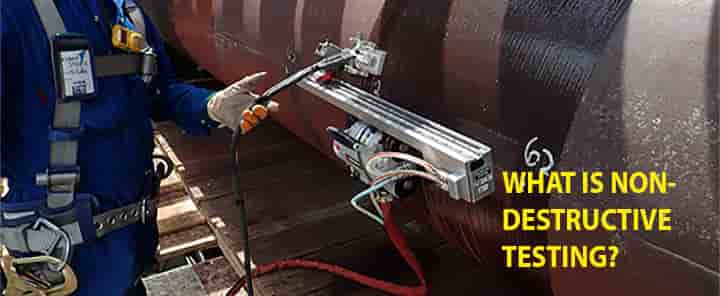
So, here we are going to know about non-destructive testing.
- The non-destructive technique is highly valuable that can save time and money in the product evaluation cycle.
- One of the best advantages is that the material properties will not be altered after testing.
Why NDT is required?
NDT is essential in many cases and there are lots of innovation and improvements have been done in case of the non-destructive testing. NDT is required, as
- NDT methods can be used for lots of materials to check their integrity, composition, or condition without the need for alteration of the materials.
- Due to non-destructive methods, it helps to save a lot of materials, money, time, labor, etc.
- NDT is safe except for radiographic testing, so, safe for the people who are doing the test.
- This method provided accurate results and it is the most efficient method.
- The use of advanced techniques has made the NDT methods better and accurate.
- Like, Analysing and documenting a non-destructive failure mode can also be accomplished using a high-speed camera recording continuously (movie-loop) until the failure is detected in the material.
These are the top reasons NDT is used by so many companies throughout the world: There are lots of methods used in non-destructive testing. We will see 8 non-destructive testing methods in brief detail. NDT methods use electromagnetic radiation, ultrasonic, magnetic particle, liquid penetrant, etc conversions according to methods.
Methods of Non-Destructive Testing
We are going to check out the 8 methods that are generally used in the NDT. The each of the methods are based on different principles. There are also sub-types of these processes but we will check that later. For now, let’s check out the different NDT testing methods.
Visual Testing
The visual testing is one of the oldest and also one of the basic non-destructive testing methods. Visual testing is mostly used for surface flaw detection, identification, and inspection of equipment and structures. Visual testing is done by using the naked eye.
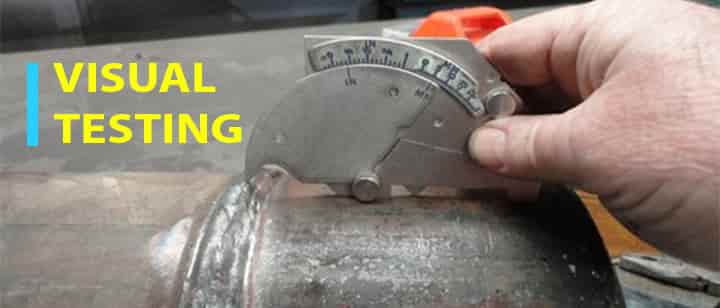
- The inspectors will inspect the material with their naked eye.
- For the testing in indoor, the help of the flashlight can be acquired.
- Also, by using the inspection cameras and placing them in the right way the remote visual inspection can be also done.
- The visual inspection testing can get help from other equipment like using optical instruments, magnifying glasses, mirrors, computer-assisted viewing systems, etc.
Advantages of visual testing
There are some advantages of visual testing,
- The process is cost-effective as no special instruments are needed.
- Visual testing is safe and non-intrusive.
- There are no equipment requirements.
Disadvantages of visual testing
There are some disadvantages of visual testing as well,
- Visual testing can be only used to detect surface flaws.
- As it’s done by humans with the naked eye, it is subjected to human errors.
- A trained and skilled tester or inspector is required.
Ultrasonic Testing
In the ultrasonic testing the high frequency sound waves are used. The high frequency sound waves are transmitted into the materials to identify the changes in the material properties.
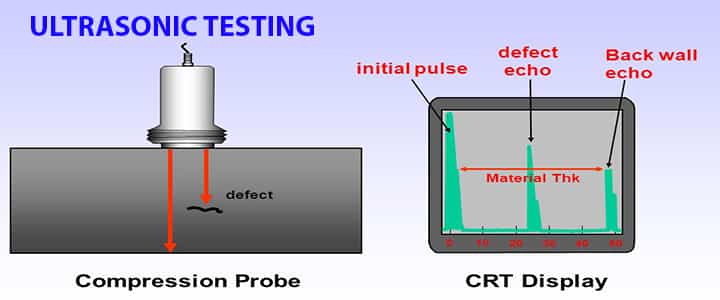
The defects in the materials can be detected using ultrasonic testing which has smooth surfaces.
- If we dig up more, the ultrasonic testing uses a transducer connected to a diagnostic machine.
- It will send the vibrations or sound waves through the material to be tested.
- The signal being sent is received by two methods. First of them is the reflection, in which the transducer will do both the works of sending and receiving the signal.
- The other method is attenuation in which the transmitter will send the ultrasound through one surface and the other separate receiver will detect the amount coming from the other side.
- If any sound decrease happens then there is the possibility of defects.
Advantages of ultrasonic testing
There are some advantages of ultrasonic testing,
- There is high penetrating power that will allow the flaws to be detected even in the deepest region of the parts.
- It has high sensitivity, even if the flaws are very small, they will be detected.
- The process can be carried out in a portable and automatic operation way.
- There is no hazard to the operator.
- Ultrasonic testing will give immediate results.
- The accuracy is better than other non-destructive testing methods. It is able to detect even minute flaws.
A NICE VIDEO from TWI Global,
Disadvantages of ultrasonic testing
There are some disadvantages of visual testing as well,
- The manual operations can be only by experienced technicians. The signals coming from the transducers should be differentiated by a skilled technician.
- In-depth technical knowledge is required for the steps and procedures of ultrasonic testing.
- The ultrasonic testing is not good for rough surfaces or irregular objects.
- The objects to be tested must be water-resistant.
Radiography Testing
The radiography is one of the NDT methods using the gamma or x-radiation on materials for the identification of the defects. In the radiography testing, a test object will be exposed to the penetrating radiation so that the radiation will be passing through the test specimen. Also, the recording medium is placed opposite side of that object.
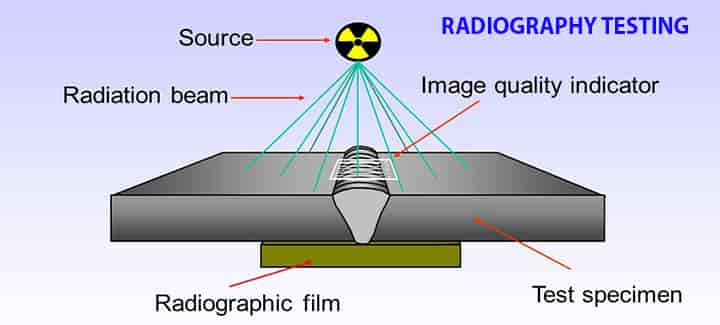
- The thinner materials are exposed to the X-radiation (X-rays) whereas for the thicker materials the gamma radiations are used.
- So, after transferring the rays through the specimen to the detector the readings from the detector are obtained.
- Thus, radiography is used for the detection alteration of the materials which can’t be seen via the naked eye.
Let’s check out some of the advantages and disadvantages of the same.
Advantages of Radiography testing
There are some advantages of radiography testing,
- The material limitations for the radiography testing are less.
- The internal defects like in the pipelines can be detected.
- Part preparation mostly not needed.
- The documentation capability of the radiography is an important advantage of radiography testing.
- The captured results can be viewed by multiple operators hence the accuracy level is high.
Disadvantages of Radiography testing
There are some disadvantages of radiography testing,
- The few seconds of expose to the rays used in RT can be harmful and may lead to injuries.
- High degree of skill is required for the exposure and interpretation of the results.
- Expensive method.
- High voltage is needed for the x-rays that is also dangerous for human health.
Eddy Current Testing
As the name suggests, this method used the eddy current for the non-destructive testing of the materials.
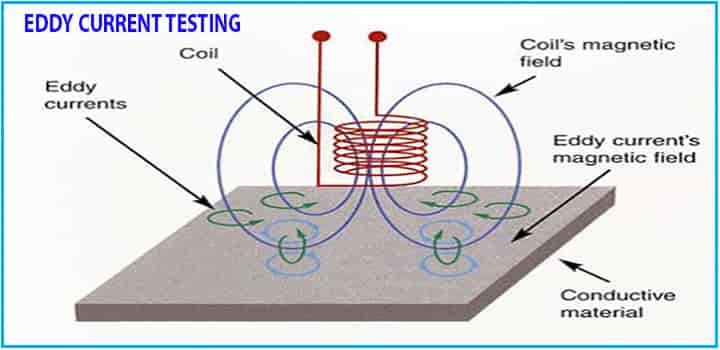
It calculates the strength of electrical currents known as the eddy currents that are surrounding the material for the determination of the materials for the location of defects.
- The eddy current testing is based on the concept of electromagnetic induction.
- So, in this method, if the defect is present and it is in the path of the eddy currents the current will flow around the defect.
- So, now the path of the eddy current will be lengthened, thereby increasing the resistance.
- As the resistance will increase the strength of the magnetic field will decrease and thus the measurements will be carried.
- Hence, when there will be a decrease in the coil current it will be an indication of the defect present in the material.
Advantages of eddy current testing
There are some advantages of eddy current testing,
- The records are partially computerized.
- The eddy current testing is also effective on the coating and paints.
- It is very sensitive and can respond to even slight changes.
- The eddy current testing is can be used as portable.
Disadvantages of eddy current testing
There are some disadvantages of eddy current testing,
- The process is slow.
- It can be used for conductive materials only.
- Eddy current testing can be used for near-surface flaws only.
- No permanent records if not automated.
Magnetic Particle Testing
The magnetic particle inspection is used for the detection of the surface and subsurface defects. Also, it is commonly used in the outdoors and remote locations.
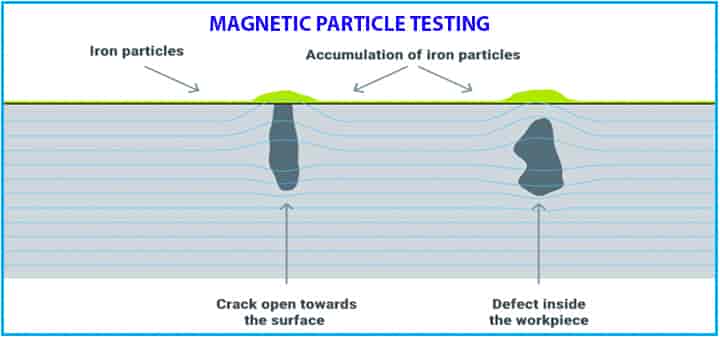
The process is based on the concept of magnetic flux leakage.
- In the process, the part will be magnetized by direct and indirect means.
- The direct magnetization will occur when the electric current will be passed through the test specimen and the magnetic field forms in the materials.
- Whereas the indirect magnetization doesn’t involve current applied to the material but it will occur when the magnetic field will be applied from the outside source.
- After inducing the magnetic field, the surface of the material is then covered with iron particles.
- It will reveal the disruptions in the flow of the magnetic field. So, these imperfections will be the locations of those defects.
Advantages of magnetic particle testing
There are some advantages of magnetic particle testing,
- The process is quick and relatively less complicated.
- It gives off the immediate indications of the defects.
- The process is inexpensive compared to the radiography process.
- Large as well as small objects can be examined.
Disadvantages of magnetic particle testing
There are some disadvantages of magnetic particle testing,
- The method is restricted to ferromagnetic materials like iron, steel.
- If a thick coat of paint is available the method cannot be used.
Acoustic Emission Testing
The acoustic emission makes use of the acoustic emission for the identification of the possible defects and imperfection in the materials. Acoustic Emission, according to ASTM, refers to the generation of transient elastic waves during the rapid release of energy from localized sources within a material.
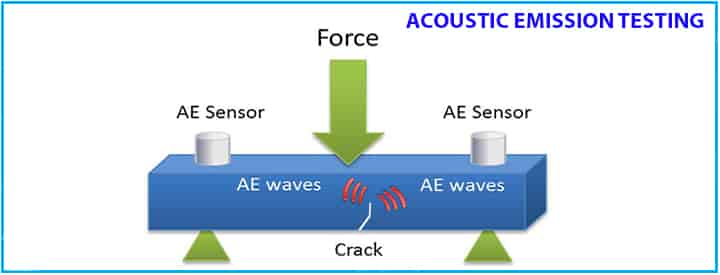
- The inspectors or testers will examine the materials for acoustic energy. They are also known as acoustic emissions.
- These emissions will be caused by defects in the materials.
- The intensity, location, and arrival time are to be examined for information about possible defects in the materials.
Advantages of acoustic emission testing
There are some advantages of emission testing,
- The testing has ability to detect wide range damage mechanisms like fibre, breakages, friction, impacts etc.
- The testing can be conducted during the operation, during testing or development testing.
- Global monitoring of the structure is possible.
- The process can be conducted remotely.
- It can detect the damages or defects that are difficult to access with conventional NDT methods.
Disadvantages of acoustic emission testing
There are some disadvantages of emission testing,
- Limited to assessing structural integrity or machine health by locating issues
- It is slower than other non-destructive testing methods.
Dye Penetrant Testing
The dye penetrant testing is one of the methods used for the detection of casting, forging, welding surface defects. The process is based on the capillary action concept.
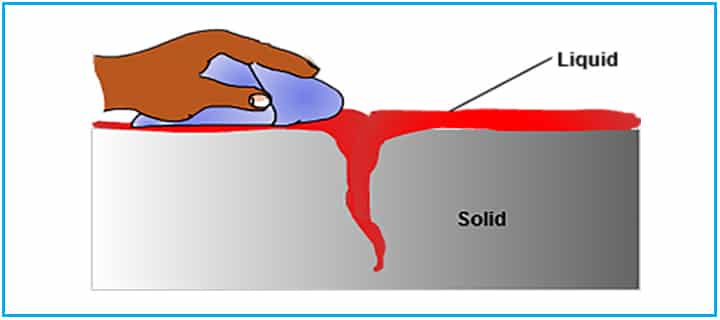
The capillary action occurs when the combination of surface tension or the liquid penetrant and the adhesive forces of the walls of the crack work together to cause the liquid to climb and colour the developer.
- In this process, the part is cleaned thoroughly and any disturbance restricting the penetrant is removed.
- The penetrant will be applied on the part and will be left for it to sink. Later the excess penetrant is removed.
- The developer will be applied which will draw the penetrant out of any defects coloring the area.
- Hence thereby visually inspecting the defects will be revealed.
Advantages of dye penetrant testing
There are some advantages of dye penetrant testing,
- The process is low cost.
- It is a fast process.
- The training required for this method is limited.
Disadvantages of dye penetrant testing
There are some disadvantages of dye penetrant testing,
- Only the surface defects can be detected.
- It can produce skin irritation.
Leak Testing
As the name suggests the leak testing is studying of the leaks in a vessel or structure for identification of the defects in the materials. It is basically used for fluid systems defect detections.
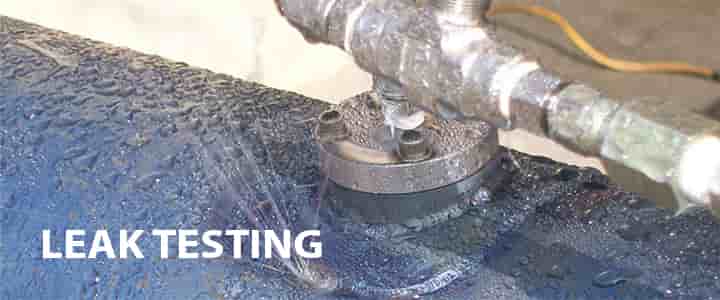
If you didn’t know, the leaks require pressure difference for the generation of flow from higher to lower pressures.
- There are lots of methods used for the detection of flow like pressure decay, mass airflow, observation, gas tracer, etc.
- The inspectors in this process detect the leaks taken via pressure gauge, soap bubble tests, etc.
- The leak testing method is mostly used in the industries like oil and gas, power generation, chemicals, mining, etc.
Advantages of leak testing
There are some advantages of leak testing,
- The methods of leak testing are some inexpensive.
- The method is safe.
- It is an easy process.
Disadvantages of leak testing
There are some disadvantages of leak testing,
- The leak testing is highly operator dependant.
- The process required close supervision.
Now we have known the non-destructive general methods and the concept. Let’s check out the difference between non-destructive testing and destructive testing.
Difference Between Non-Destructive & Destructive Testing
The main differences between non-destructive testing and destructive testing are captured below,
| Sr No. | Non-destructive testing | Destructive testing |
| 1 | The non-destructive methods are used for finding out the defects of materials. | The destructive ones are used for finding out the properties of the materials. |
| 2 | The load is not applied in NDT. | The load is applied in case of destructive testing. |
| 3 | There is no requirement of the special equipment’s. | There is load applied, hence the material gets damaged. |
| 4 | The NDT methods are relatives inexpensive. | The DT methods are relatively costly. |
| 5 | The material properties or structure is not altered nor material is destroyed. | The material properties are altered also material can be destroyed. |
Code & Standards of Non-Destructive Testing
American Society for Nondestructive Testing (ASNT)
American Society of Mechanical Engineers (ASME)
American Petroleum Institute (API)
American Welding Society (AWS)
ASTM International
European Committee for Standardization (CEN)
European Pressure Equipment Directive (PED)
International Organization for Standardization (ISO)
ISO 9712:2012
— Non-destructive testing — Qualification and certification of NDT personnel
National Board of Boiler and Pressure Vessel Inspectors (NBBI)
Non-Destructive Testing Company
There are a lot of companies, who provides ND services,
- Applied Technical Services
- Arora Technologies (P) Limited
- Baker Hughes
- Innerspec Technologies, Inc.
- Mistras Group, Inc.
- NVI Non-destructive & Visual Inspection
- National Inspection Services LLC
- NDTS India (P) Limited.
- NDT Global LLC
- TEAM, Inc.
- TesTex, Inc.
- Triumph Group
- Welding Inspection Services Ltd
Conclusion
Hope, we have got a clear idea about non-destructive testing along with it’s various methods. Any doubt, please write in the below comment box.
